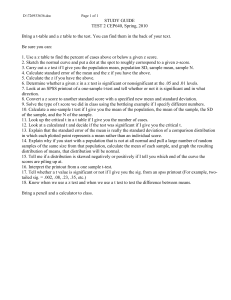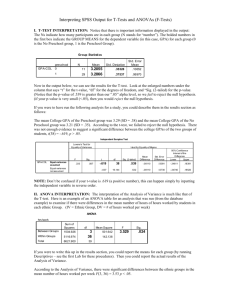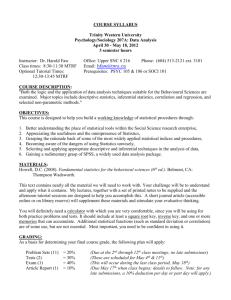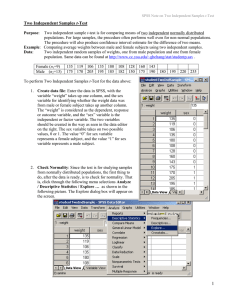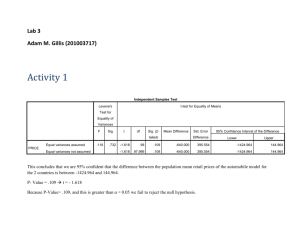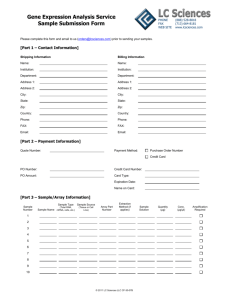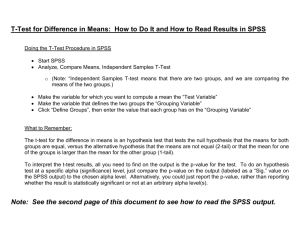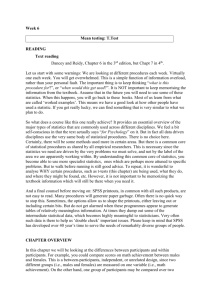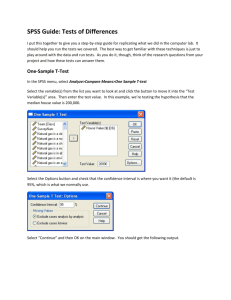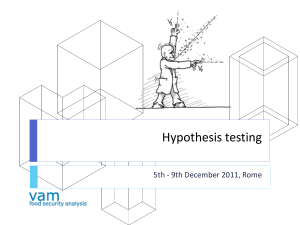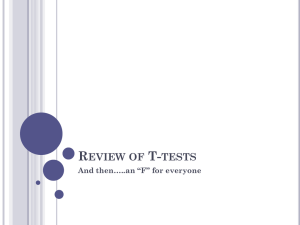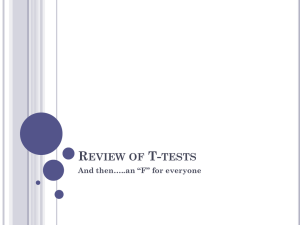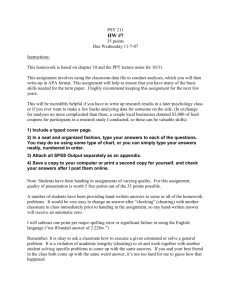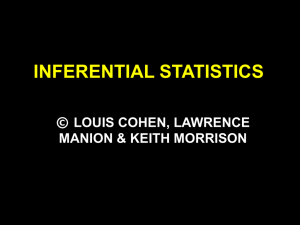SPSS Assignment Template for Steps 2, 3, and 4
advertisement
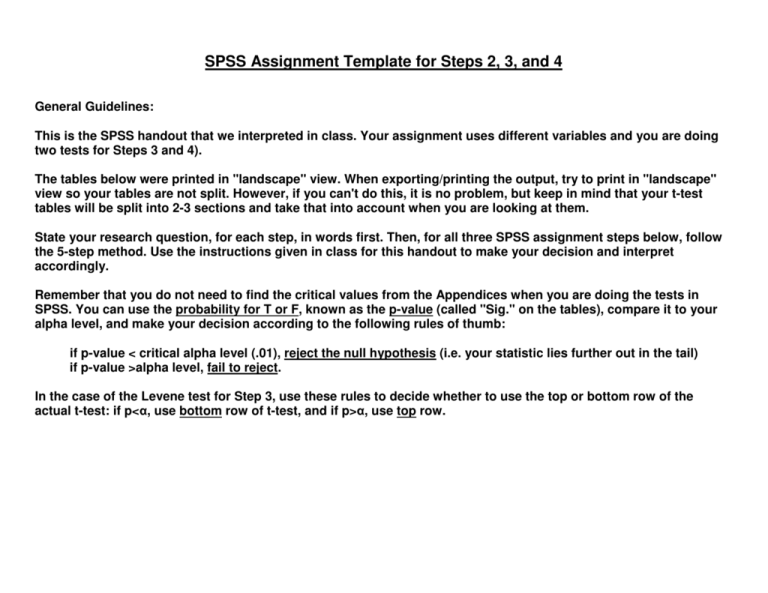
SPSS Assignment Template for Steps 2, 3, and 4 General Guidelines: This is the SPSS handout that we interpreted in class. Your assignment uses different variables and you are doing two tests for Steps 3 and 4). The tables below were printed in "landscape" view. When exporting/printing the output, try to print in "landscape" view so your tables are not split. However, if you can't do this, it is no problem, but keep in mind that your t-test tables will be split into 2-3 sections and take that into account when you are looking at them. State your research question, for each step, in words first. Then, for all three SPSS assignment steps below, follow the 5-step method. Use the instructions given in class for this handout to make your decision and interpret accordingly. Remember that you do not need to find the critical values from the Appendices when you are doing the tests in SPSS. You can use the probability for T or F, known as the p-value (called "Sig." on the tables), compare it to your alpha level, and make your decision according to the following rules of thumb: if p-value < critical alpha level (.01), reject the null hypothesis (i.e. your statistic lies further out in the tail) if p-value >alpha level, fail to reject. In the case of the Levene test for Step 3, use these rules to decide whether to use the top or bottom row of the actual t-test: if p<α, use bottom row of t-test, and if p>α, use top row. Assignment Step 2: Single-sample T-Test (comparing the sample mean (25.278) to the population or test value of 40 hours) Research question: Is there a significant difference between the sample mean and the population parameter in # of hours worked per week? One-Sample Statistics N Number of hours usually 1512 worked at all jobs in a week. Mean Std. Deviation 25.278 Std. Error Mean 20.5113 .5275 One-Sample Test Test Value = 40 t df Sig. (2-tailed) Mean Difference 99% Confidence Interval of the Difference Lower Number of hours usually worked at all jobs in a week. -27.907 1511 .000 -14.7222 Upper -16.083 -13.362 Five Step Method: 1. Make Assumptions and meet test requirements. Follow guidelines in powerpoint slides. 2. State the null/alternate hypothesis: H0: µ = 40 (no difference) and H1: µ ≠ 40 (there is a difference) 3. Select the sampling distribution and establish the critical region. Use T-test. (Note that SPSS uses t-test instead of z-test) Since n>1000, α=.01 4. Compute the test statistic. See One-sample table above for computation. 5. Make a decision: t = -27.907 p (Sig.) = .000 which is less than α=.01, so reject H0 Interpretation: The sample mean = 25.278 is significantly different from the population mean in # of hours worked per week (t = -27.907, df=1511, α=.01) Assignment Step 3: Two-sample T-Test comparing the sample mean for "Yes, limited in activity" (20.680) to the sample mean for "No, not limited" (27.129) in # of hours worked. Research question: Is there a significant difference between the sample means in # of hours worked per week? Group Statistics Are you limited in the amount N Mean Std. Deviation Std. Error Mean or kind of activity you can do Number of hours usually Yes 434 20.680 21.2104 1.0182 worked at all jobs in a week. No 1078 27.129 19.9355 .6072 Independent Samples Test Levene's Test for Equality of t-test for Equality of Means Variances F Number of hours usually Equal variances assumed 20.995 Sig. t .000 df Sig. (2-tailed) Mean Std. Error Difference Difference 99% Confidence Interval of the Difference Lower Upper -5.586 1510 .000 -6.4494 1.1546 -9.4273 -3.4715 -5.440 757.219 .000 -6.4494 1.1855 -9.5108 -3.3881 worked at all jobs in a Equal variances not assumed week. Five Step Method: 1. Make Assumptions and meet test requirements. Follow guidelines in powerpoint slides for two-sample tests. 2. State the null/alternate hypotheses: H0: µ1 = µ2 (no difference) H1: µ1 ≠ µ2 (there is a difference) 3. Select the sampling distribution and establish the critical region. Use T-test. Since n>1000, α=.01 (Note that SPSS uses t-test) 4. Compute the test statistic. See Two-sample table above for computation. 5. Make a decision: a) Levene's test: Since p (Sig.) = .000 < α=.01, we are going to use the bottom (unequal variances) row of the t-test b) t = -5.440 p (Sig.) = .000 which is less than α=.01, so reject H0 Interpretation: The sample mean for "Yes" = 20.680 is significantly different* from "No" = 27.167 in # of hours worked per week. *Report your sig. stats: (t = -5.440, df=757.219, α=.01) Assignment Step 4: Oneway ANOVA # of Hours Worked by Health Status Research question: Is there a significant difference in # of hours worked per week by Health Status? ANOVA Number of hours usually worked at all jobs in a week. Sum of Squares Between Groups df Mean Square 13639.472 4 3409.868 Within Groups 621957.012 1506 412.986 Total 635596.484 1510 F 8.257 Sig. .000 Post Hoc Tests - Homogeneous Subsets Number of hours usually worked at all jobs in a week. Tukey B In general, would you say your N Subset for alpha = 0.01 health is: ... poor? 1 2 33 11.869 ... fair? 113 18.566 ... good? 355 24.594 ... excellent? 440 26.192 ... very good? 568 27.133 18.566 Five Step Method: 1. Make Assumptions and meet test requirements. Follow guidelines in powerpoint slides for ANOVA. 2. State the null/alternate hypotheses: H0: µ1= µ2=µ3=µ4=µ5 H1: at least 1 mean is different. 3. Select the sampling distribution and establish the critical region. F-test. Since n>1000, α=.01 4. Compute the test statistic. See ANOVA above for computation, then look at Tukey b table to see which means are different. 5. Make a decision: a) ANOVA table: F = 8.257, p (Sig.) = .000 < α=.01 therefore reject H0 b) Tukey b test: the mean for poor is significantly different from the means for good, excellent, very good (α=.01) Interpretation: There is a significant difference in the sample means of # hours worked by health status (F=8.257, df=4,1505, α=.01). The mean for poor (11.869) is not different from fair (18.566) but is significantly different from good (24.594), excellent (26.192) and very good (27.133).
